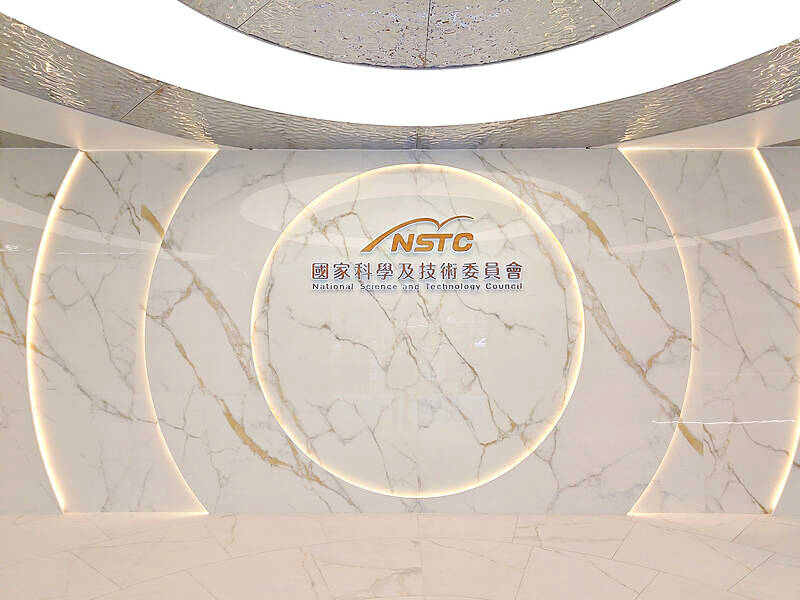The National Science and Technology Council (NSTC) yesterday said it would lead the development of Taiwan’s sovereign artificial intelligence (AI) by boosting the combined computing speed of the nation’s supercomputers to 480 petaflops by 2029.
AI sovereignty refers to a country’s full autonomy over AI technologies and infrastructure, including the development of models, control and protection of data, and ensuring computing efficiency, NSTC Deputy Minister Lin Faa-jeng (林法正) said.
The NSTC’s goal is to reduce Taiwan’s dependence on external technologies and services, he said.

Photo: Wu Po-hsuan, Taipei Times
Last year, 80 percent of corporate chief executive officers recognized AI’s influence, while 57 percent included AI in their development strategies, Lin said, citing data from Gartner, a US technological research and consulting firm.
Taiwan’s domestic demand for AI is increasing every year, including large-scale language model training, climate change research, healthcare innovations, smart manufacturing and integrated circuit layout, he said, adding that the council has commissioned the National Center for High-Performance Computing to procure supercomputers to reach the necessary computing speed for AI, he added.
One type of supercomputer is driven by regular CPUs, including Taiwania 3 and Forerunner 1, which can reach 2.7 petaflops and 3.5 petaflops respectively, he said.
Another type is GPU-powered supercomputers such as Taiwania 2 and the Trustworthy AI Dialog Engine (TAIDE) language model, capable of 5.9 petaflops and 3.8 petaflops respectively, Lin said.
Cloud services and technology platforms would also be built to promote Taiwan’s academic research development, industrial applications and international competitiveness in the AI field, he added.
Additionally, the council plans to launch a scheme to construct next-generation high-speed host computers under the Taiwan Chip-based Industrial Innovation Program, Lin said.
The scheme aims for supercomputers’ combined computing speed to reach 280 petaflops by 2028, he added.
More AI supercomputers would be installed under the “Southern Silicon Valley” project to add another 200 petaflops from next year to 2029, Lin said.
The combined computing speed of supercomputers would thus reach 480 petaflops within the next five years, he added.
ChatGPT has shown the power of generative AI and the importance of sovereignty over the technology since its launch in 2022, he said.
Sixty to 70 percent of mainstream AI models are trained in English, and most of the ones in Mandarin use simplified Chinese, Lin said.
The construction of TAIDE would ensure the nation’s competitiveness by developing a model in Traditional Chinese, he said.
The center would not only create high-efficiency supercomputers based on GPUs, but also build a reliable cloud data environment, ensuring the safety of sensitive medical data, such as people’s genomes or health records, Lin added.

MISINFORMATION: The generated content tends to adopt China’s official stance, such as ‘Taiwan is currently governed by the Chinese central government,’ the NSB said Five China-developed artificial intelligence (AI) language models exhibit cybersecurity risks and content biases, an inspection conducted by the National Security Bureau (NSB) showed. The five AI tools are: DeepSeek, Doubao (豆包), Yiyan (文心一言), Tongyi (通義千問) and Yuanbao (騰訊元寶), the bureau said, advising people to remain vigilant to protect personal data privacy and corporate business secrets. The NSB said it, in accordance with the National Intelligence Services Act (國家情報工作法), has reviewed international cybersecurity reports and intelligence, and coordinated with the Ministry of Justice Investigation Bureau and the National Police Agency’s Criminal Investigation Bureau to conduct an inspection of China-made AI language

BOOST IN CONFIDENCE: The sale sends a clear message of support for Taiwan and dispels rumors that US President Donald Trump ‘sold out’ the nation, an expert said The US government on Thursday announced a possible sale to Taiwan of fighter jet parts, which was estimated to cost about US$330 million, in a move that an expert said “sends a clear message of support for Taiwan” amid fears that Washington might be wavering in its attitude toward Taipei. It was the first announcement of an arms sale to Taiwan since US President Donald Trump returned to the White House earlier this year. The proposed package includes non-standard components, spare and repair parts, consumables and accessories, as well repair and return support for the F-16, C-130 and Indigenous Defense Fighter aircraft,

CHECKING BOUNDARIES: China wants to disrupt solidarity among democracies and test their red lines, but it is instead pushing nations to become more united, an expert said The US Department of State on Friday expressed deep concern over a Chinese public security agency’s investigation into Legislator Puma Shen (沈伯洋) for “secession.” “China’s actions threaten free speech and erode norms that have underpinned the cross-strait ‘status quo’ for decades,” a US Department of State spokesperson said. The Chongqing Municipal Public Security Bureau late last month listed Shen as “wanted” and launched an investigation into alleged “secession-related” criminal activities, including his founding of the Kuma Academy, a civil defense organization that prepares people for an invasion by China. The spokesperson said that the US was “deeply concerned” about the bureau investigating Shen

LIMITS: While China increases military pressure on Taiwan and expands its use of cognitive warfare, it is unwilling to target tech supply chains, the report said US and Taiwan military officials have warned that the Chinese People’s Liberation Army (PLA) could implement a blockade within “a matter of hours” and need only “minimal conversion time” prior to an attack on Taiwan, a report released on Tuesday by the US Senate’s China Economic and Security Review Commission said. “While there is no indication that China is planning an imminent attack, the United States and its allies and partners can no longer assume that a Taiwan contingency is a distant possibility for which they would have ample time to prepare,” it said. The commission made the comments in its annual